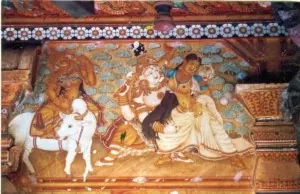The Hindu mythology encompasses stories from all walks of life, teaching us about the endless aspects of this universe. In addition to topics revolving around the existence of the world – its sustenance, destiny, war, love and so on. And another important theme that can be seen throughout the texts are the fascinating LGBTQ+ representations!
People from the LGBTQIA+ community have always been wrongly labelled as being unnatural and accused of going “against” our Indian Values. Although, according to Hindu religious texts, alternate sexual choices are perfectly natural; encouraged and supported by many.
So here are a few stories from our Indian scriptures that are perfect examples of how the Indian Culture was; and should remain, extremely accepting. The Hindu Mythology has recognized the spectrum of sexuality since long back!
Shikhandi From Woman to Man:

Image courtesy: en.wikipedia.org
The tale of Shikhandi, formerly Shikhandini, is arguably the most popular example of a Trans-sexual person, written in the Mahabharata.
It is said that Shikhandi, born in his previous life as a female called Amba, was destined to be the cause of the downfall of Bhishma Pitamah; as he was the reason why Amba was humiliated and disowned by all; her father, her lover, and her future husband (whom she had to marry against her will).
In her next life, Amba was born a female to King Drupada, who wanted a son and was promised the same by Lord Shiva. Thus, he raised Shikhandini as a man and a warrior. The King also got her married to a princess. But in order to satisfy the princess, Shikhandini fled into the forest, where she met a Yaksha, and exchanged genders; now becoming Shikhandi.
Read More: Some Of The Best LGBTQ+ Films That Perfectly Portray The Queer Experience
Later, during the Battle of Mahabharata, Shikhandi was brought to the battlefield and confronted by Bhishma Pitamah, who laid down all his weapons as he believed, “Once a woman, always a woman.” Arjun (The archer prince and one of the 5 Pandavas) took this opportunity and released a multitude of arrows and pinned Bhishma Pitamah to the ground, which was pivotal for the Pandavas to win the battle.
Budha Graha (Planet Mercury) & Ila; The Non-Binary Gods:

Image courtesy: en.wikipedia.org
Another fascinating example from the Mahabharata is that of Budha Graha, or the planet Mercury, who was neither male, nor female. Budha was born of the illegitimate union of Tara (Goddess of the stars) and Chandra (God of the Moon). When Brihaspati (Planet Jupiter) found out about this union between his wife and The Moon God, he was enraged. He went on to curse the unborn child Budha; saying the child will be born neither male, nor female.
As fate would have it, Budha went on to marry Prince Sudyumna, who, as a result of a spell cast by Lord Shiva, had turned into a woman- Ila. Due to this spell, Sudyumna, or Ila, would become a man when the moon waxed (the moon growing fuller) and a woman when the moon waned (the moon getting slimmer in appearance).
Thus, happened the intriguing pairing of Budha, who was neither man nor woman (non-binary identity); and Ila, who was both man and woman (Intersex individual).
Read More: Queer books by Indian Authors You Must Read
Lord Vishnu And Gender Fluidity:

Image courtesy: arjuna-vallabha.tumblr.com
It is a well-established fact, that Lord Vishnu, considered the protector of the world, had a Gender-fluid personality.
As the story goes, an Asura once pleased Lord Shiva and acquired the ability to turn into ashes, anyone on whose head he set his hand. This Asura came to be known as Bhasma-asura, the one who turns everyone into ashes by his touch. The cunning Asura planned to use his powers on Lord Shiva himself, saying he wants proof of the validity of this ‘boon’.
When Lord Shiva came to know of this plan, he turned to Lord Vishnu for help. Lord Vishnu then turned himself into the enchanting Apsara Mohini (the female form of Lord Vishnu) to distract Bhasma. Overcome by desire, Bhasma asked Mohini to marry him. But Mohini had a condition; she would only marry Bhasma if he could dance like her. To win Mohini’s heart, Bhasma started imitating Mohini’s dance.
Through the course of her dance, Mohini placed her hand on her head, and simultaneously, Bhasma did so too, turning himself into ashes!
Lord Shiva, at this point got lost in the beauty of Mohini and abandoning his wife Parvati, he pursued Mohini. Together he and Mohini produced numerous incredible heroes, the individuals who decided to remain abstinent and shield the world from demons. Amongst them were Ayyappa, Aiyanar, and even Hanuman.
Read More: Gay/Lesbian Disney Characters You SHOULD Know About!
Acceptance With an Open Mind:
Up until the western world pointed out its queer nature; these historical stories were never an embarrassment. We, as a culture, have welcomed all with open arms.
“In this great land, it is the soul that is important. The body is just temporary.”
This is the teachings of Lord Krishna. He says, “The true meaning of enlightenment is to go beyond all things worldly. And to achieve this, we, as people, must start accepting the infinite possibilities that the universe throws up.”
So why not learn to accept, celebrate and cherish people whose choices are different and unique in their own ways! Because the only way to achieve the highest form of wisdom is to let go of all the self-established barriers; and wisdom expands the mind!



2 thoughts on “Fascinating LGBTQ+ Representations from Hindu Mythology ”